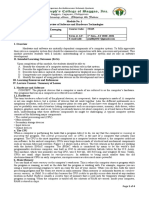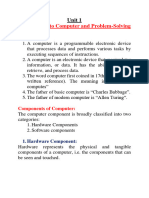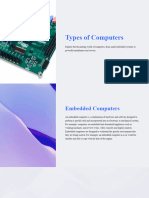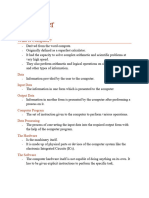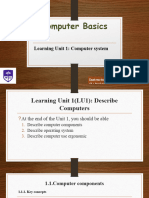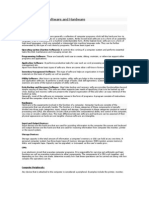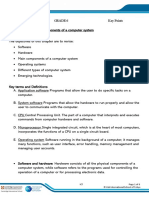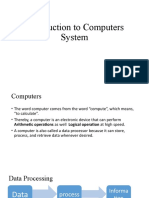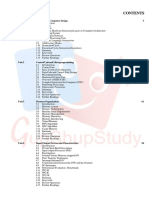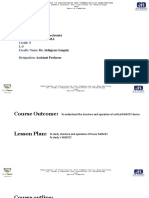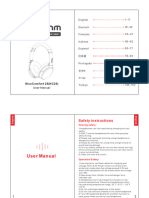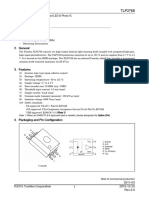Summary of Introduction To Computer Systems
Uploaded by
ScribdTranslationsSummary of Introduction To Computer Systems
Uploaded by
ScribdTranslationsBOLIVARIAN REPUBLIC OF VENEZUELA
MINISTRY OF PEOPLE'S POWER FOR DEFENSE
NATIONAL EXPERIMENTAL POLYTECHNIC UNIVERSITY
FROM THE ARMED FORCES
MIRANDA NUCLEUS
OCUMARE DEL TUY EXTENSION
7th SEMESTER OF SYSTEMS ENGINEERING NIGHT SCHOOL
INTRODUCTION TO THE
SYSTEMS
ABOUT COMPUTING
Professor: Students:
Iván Ricciari ORIGUEN, Yhonatan C.I.:
YBARRA, Kelly C.I.:
MEZA, Yermainen C.I.
GOMEZ, Lawrence C.I.:
Ocumare del Tuy, April 2011
SUMMARY OF INTRODUCTION TO SYSTEMS
COMPUTATION
A computer is made up of hardware and software,
understood as software being the logical part and hardware being the part
physical or tangible computer that works or interacts in some way with the
computer
Initially, computers did not have software and performed
logical and mathematical operations using logic gates,
such as: AND, OR, NOT, among others.
Hardware not only includes internal elements like the hard drive, CD-
ROM, disk drive, but also refers to the wiring, circuits,
cabinet, etc. And it even refers to external elements such as the printer,
the mouse, the keyboard, the monitor and other peripherals. The hardware depends on
software, which is intangible and provides logic to the hardware, also runs within
this. The hardware is not frequently changed, while the software can be
created, deleted, and modified simply, except for the firmware, which is a
type of software that is rarely altered.
The typical hardware that makes up a personal computer is as follows:
Its chassis or cabinet
The motherboard, which contains: CPU, cooler, RAM, BIOS, buses (PCI,
USB, HyperTransport, CSI, AGP, etc.
Power supply
Storage controllers: IDE, SATA, SCSI
Video controller
Computer bus controllers (parallel, serial, USB, FireWire),
to connect it to peripherals
Storage: hard drive, CD-ROM, floppy disk drive, ZIP drive and others
Sound card
Networks: modem and network card
Hardware is classified as follows:
Classification by hardware functionality:
Basic hardware: devices needed to start the computer. The most
the basics are the motherboard, the power supply, the microprocessor and the
memory. Components such as monitor and keyboard could be included, although not
are strictly basic.
Complementary hardware: those devices that complement the
computer, but which are not essential for its operation, such as
server, printer, storage units, etc.
Classification by the location of the hardware
Peripherals (external components): external devices to the computer.
See peripheral
Internal components: devices that are internal to the cabinet of the
computer
Ports: connect peripherals with internal components.
Classification by the flow of information of the hardware
Output peripherals: monitor, printer, etc.
Input peripherals: keyboard, mouse, etc.
•Peripherals/storage devices: hard drive, memory sticks, etc.
Communication peripherals: modem, ports, etc.
Processing devices: CPU, microprocessor, motherboard, etc.
Software in a broad sense is more than just programs. This
definition includes:
•The representation of the software: programs, design details written in a
program description language, architecture design,
written specifications in formal language, system requirements, etc.
The knowledge of software engineering: It is all the information
related to software development (for example, how to use a method
specific design) or the information related to the development of software
specific (for example, the testing scheme in a project). Here it is
includes information related to the project, information about the technology
of software, knowledge about similar systems and the information
detailed related to the identification and solution of technical problems.
Software as a program: Software, as a program, consists of a
code in a machine language specific to an individual processor. The
code is a sequence of ordered instructions that change the state of
hardware of a computer.
Software is usually written in a high-level programming language.
what is easier to write (as it is closer to natural human language),
but it must be converted to machine language to be executed.
Software can be categorized into three types:
System software: helps the hardware and the computer to function.
Includes the operating system, device drivers, tools of
diagnosis, servers, window system, utilities and more. Its purpose is
avoid the most complex details of computing as much as possible, especially
the memory and the hardware.
•Programming software: provides tools to assist the programmer.
Includes text editors, compilers, instruction interpreters,
linkers, etc.
Application software: allows end users to perform certain tasks
tasks. Some application software includes browsers, text editors,
graphic editors, antivirus, messengers, etc.
Based on the needs of the Kildall population, he invented a program.
capable of controlling the hardware in an efficient and fast way called
CP/M, copied by Tim Paterson (Renaming some Functions) and called Q-
DOS, and finally bought and patented by Microsoft called finally MS-
DOS.
Nowadays, MS-DOS is the base operating system of all versions.
from Windows, which has been improving over the years according to the
needs of the population, however there are other base operating systems
of free license like LINUX, from this it can be found in the market
distributions like UBUNTU, DEBIAN, among others.
In another line of thought, an Operating System is the software responsible for
exert control and coordinate the use of hardware among different programs
application and the different users, in an informal definition is a system that
consists of offering an organized and controlled distribution of the processors,
memories and I/O devices among the various programs that compete for
they.
The tasks that a Operating System generally performs are the
next:
Create the system-user interface.
Share hardware resources among users.
Allow users to share their data with each other.
Prevent a user's activities from interfering with those of others
users.
Schedule the users' resources.
Facilitate access to I/O devices.
Recover from failures or errors.
Keep track of the use of resources.
Among others.
An operating system is made up of several programs that together
they present the user with an integrated view of the system, the main components
the following modules are from an operating system:
Process management.
I/O management.
Memory Management.
File System Management.
The operating system tells the computer how to use others.
software programs and manages all the hardware, both internal and external
external, which is installed on the computer.
OPERATING SYSTEM STRUCTURE: Characteristics of each
one of the Structures of the OS.
Monolithic Structure:
Only one program is executed at a time (Monoprocess)
The system lacks security.
Systems are difficult to modify, since they are programmed with
subroutines.
Operating systems are designed and programmed to meet specific needs.
Structural Systems or Layered Systems:
They work on the concept of multiprogramming and multiprocessor.
They manage large volumes of information.
Greater security is implemented in these systems.
They are designed in modules.
Client/Server Model:
They handle large volumes of information.
They are safe.
Address overload.
The client-server model is based on the provision of services by
from the server to the client (the processes run on the server, and the client goes from the
hand with the graphical interface)
Kernel: It is a set of subroutines that interact
directly with the hardware including all devices that are installed:
Process management, memory management, I/O management (processes of
input/output), exception and interrupt management, file management and
directories
A database system is divided into modules, each one
of which it controls a part of the total responsibility of the system. In the
in most cases, the operating system provides only the services
more basic and the database system must start from that basis and control
In addition, the correct handling of data. Thus, the design of a database system
data must include the interface between the database system and the system
operative.
It is worth noting that the new generations of computers
they are aimed at games and multimedia




























